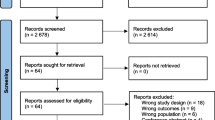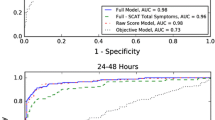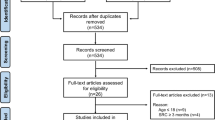Abstract
Background
The immediate post concussion assessment and cognitive testing (ImPACT) is the most widely used concussion assessment tool. Despite its popularity, it is unclear if validation studies for the ImPACT test covered all aspects of validity to support its widespread use in research and clinical practice.
Objective
The purpose of this report is to review literature surrounding the validity and the utility of the ImPACT test.
Data sources and appraisal
A systematic review of relevant studies in PubMed, CINAHL, and PsycINFO was carried out. Studies were evaluated using the STROBE (strengthening the reporting of observational studies in epidemiology) or the STARD (standards for reporting of diagnostic accuracy) criteria.
Results
The literature search yielded 5968 studies. Sixty-nine studies met the inclusion criteria and were included in the qualitative review. Although the convergent validity of ImPACT was supported, evidence of discriminant and predictive validity, diagnostic accuracy and responsiveness was inconclusive. The utility of the ImPACT test after acute symptom resolution was sparse. The review found many factors influenced the validity and utility of ImPACT scores.
Conclusion
Clinicians must consider the benefit of ImPACT testing for their patients on a case-by-case scenario and must take the psychometric properties of the test into account when interpreting results.

Similar content being viewed by others
References
McCrory P, Meeuwisse WH, Aubry M, et al. Consensus statement on concussion in sport: the 4th International Conference on Concussion in Sport held in Zurich, November 2012. Br J Sports Med. 2013;47:250–8.
Broglio SP, Cantu RC, Gioia GA, et al. National Athletic Trainers’ Association position statement: management of sport concussion. J Athl Train. 2014;49:245–65.
Covassin T, Elbin R 3rd, Stiller-Ostrowski JL. Current sport-related concussion teaching and clinical practices of sports medicine professionals. J Athl Train. 2009;44:400–4.
Randolph C, McCrea M, Barr WB. Is neuropsychological testing useful in the management of sport-related concussion? J Athl Train. 2005;40:139–52.
Mayers LB, Redick TS. Clinical utility of ImPACT assessment for postconcussion return-to-play counseling: psychometric issues. J Clin Exp Neuropsychol. 2012;34:235–42.
Maroon JC, Lovell MR, Norwig J, et al. Cerebral concussion in athletes: evaluation and neuropsychological testing. Neurosurgery. 2000;47:659–69.
Cole WR, Arrieux JP, Schwab K, et al. Test–retest reliability of four computerized neurocognitive assessment tools in an active duty military population. Arch Clin Neuropsychol. 2013;28:732–42.
Meehan WP 3rd, d’Hemecourt P, Collins CL, et al. Computerized neurocognitive testing for the management of sport-related concussions. Pediatrics. 2012;129:38–44.
Maroon JC, Field M, Lovell M, et al. The evaluation of athletes with cerebral concussion. Clin Neurosurg. 2002;49:319–32.
Portney L, Watkins M. Foundations of clinical research: applications to practice. Upper Saddle River: Prentice-Hall, Inc.; 2009.
Alsalaheen B, Stockdale K, Pechumer D, et al. Measurement error in the immediate postconcussion assessment and cognitive testing (ImPACT): systematic review. J Head Trauma Rehabil. 2015;. doi:10.1097/HTR.0000000000000175.
von Elm E, Altman DG, Egger M, et al. The strengthening the reporting of observational studies in epidemiology (STROBE) statement: guidelines for reporting observational studies. Ann Intern Med. 2007;147:573–7.
Bossuyt PM, Reitsma JB, Bruns DE, et al. The STARD statement for reporting studies of diagnostic accuracy: explanation and elaboration. Ann Intern Med. 2003;138:W1–12.
Collins MW, Field M, Lovell MR, et al. Relationship between postconcussion headache and neuropsychological test performance in high school athletes. Am J Sports Med. 2003;31:168–73.
Lovell MR, Collins MW, Iverson GL, et al. Grade 1 or “ding” concussions in high school athletes. Am J Sports Med. 2004;32:47–54.
Colvin AC, Mullen J, Lovell MR, et al. The role of concussion history and gender in recovery from soccer-related concussion. Am J Sports Med. 2009;37:1699–704.
Bruce JM, Echemendia RJ. History of multiple self-reported concussions is not associated with reduced cognitive abilities. Neurosurgery. 2009;64:100–6.
Echlin PS, Tator CH, Cusimano MD, et al. Return to play after an initial or recurrent concussion in a prospective study of physician-observed junior ice hockey concussions: implications for return to play after a concussion. Neurosurg Focus. 2010;29:E5.
Echlin PS, Tator CH, Cusimano MD, et al. A prospective study of physician-observed concussions during junior ice hockey: implications for incidence rates. Neurosurg Focus. 2010;29:E4.
Guskiewicz KM, Marshall SW, Broglio SP, et al. No evidence of impaired neurocognitive performance in collegiate soccer players. Am J Sports Med. 2002;30:157–62.
Ponsford J, Cameron P, Fitzgerald M, et al. Predictors of postconcussive symptoms 3 months after mild traumatic brain injury. Neuropsychology. 2012;26:304–13.
Pellman EJ, Lovell MR, Viano DC, et al. Concussion in professional football: neuropsychological testing–part 6. Neurosurgery. 2004;55:1290–303.
Peterson CL, Ferrara MS, Mrazik M, et al. Evaluation of neuropsychological domain scores and postural stability following cerebral concussion in sports. Clin J Sports Med. 2003;13:230–7.
Schatz P, Sandel N. Sensitivity and specificity of the online version of ImPACT in high school and collegiate athletes. Am J Sports Med. 2013;41:321–6.
Kontos AP, Huppert TJ, Beluk NH, et al. Brain activation during neurocognitive testing using functional near-infrared spectroscopy in patients following concussion compared to healthy controls. Brain Imaging Behav. 2014;8:621–34.
Solomon GS, Kuhn A. Relationship between concussion history and neurocognitive test performance in National Football League draft picks. Am J Sports Med. 2014;42:934–9.
Maerlender A, Flashman L, Kessler A, et al. Discriminant construct validity of ImPACT: a companion study. Clin Neuropsychol. 2013;27:290–9.
Allen BJ, Gfeller JD. The immediate post-concussion assessment and cognitive testing battery and traditional neuropsychological measures: a construct and concurrent validity study. Brain Inj. 2011;25:179–91.
Schatz P, Putz BO. Cross-validation of measures used for computer-based assessment of concussion. Appl Neuropsychol. 2006;13:151–9.
Fedor A, Gunstad J. Higher BMI is associated with reduced cognitive performance in division I athletes. Obes Facts. 2013;6:185–92.
Resch JE, Macciocchi S, Ferrara MS. Preliminary evidence of equivalence of alternate forms of the ImPACT. Clin Neuropsychol. 2013;27:1265–80.
Iverson GL, Lovell MR, Collins MW. Validity of ImPACT for measuring processing speed following sports-related concussion. J Clin Exp Neuropsychol. 2005;27:683–9.
Maerlender A, Flashman L, Kessler A, et al. Examination of the construct validity of ImPACT computerized test, traditional, and experimental neuropsychological measures. Clin Neuropsychol. 2010;24:1309–25.
Tjarks BJ, Dorman JC, Valentine VD, et al. Comparison and utility of King-Devick and ImPACT(R) composite scores in adolescent concussion patients. J Neurol Sci. 2013;334:148–53.
Parker TM, Osternig LR, van Donkelaar P, et al. Recovery of cognitive and dynamic motor function following concussion. Br J Sports Med. 2007;41:868–73.
Alsalaheen B, Whitney SL, Marchetti GF, et al. Relationship between cognitive assessment and balance measures in adolescents referred for vestibular physical therapy after concussion. Clin J Sports Med. 2015;26:46–52.
Vernau BT, Grady MF, Goodman A, et al. Oculomotor and neurocognitive assessment of youth ice hockey players: baseline associations and observations after concussion. Dev Neuropsychol. 2015;40:7–11.
Sasaki T, Pasternak O, Mayinger M, et al. Hockey Concussion Education Project, Part 3. White matter microstructure in ice hockey players with a history of concussion: a diffusion tensor imaging study. J Neurosurg. 2014;120:882–90.
Broglio SP, Sosnoff JJ, Ferrara MS. The relationship of athlete-reported concussion symptoms and objective measures of neurocognitive function and postural control. Clin J Sports Med. 2009;19:377–82.
Kontos AP, Covassin T, Elbin RJ, et al. Depression and neurocognitive performance after concussion among male and female high school and collegiate athletes. Arch Phys Med Rehabil. 2012;93:1751–6.
Sandel NK, Lovell MR, Kegel NE, et al. The relationship of symptoms and neurocognitive performance to perceived recovery from sports-related concussion among adolescent athletes. Appl Neuropsychol Child. 2013;2:64–9.
Covassin T, Elbin RJ 3rd, Larson E, et al. Sex and age differences in depression and baseline sport-related concussion neurocognitive performance and symptoms. Clin J Sports Med. 2012;22:98–104.
Barlow M, Schlabach D, Peiffer J, et al. Differences in change scores and the predictive validity of three commonly used measures following concussion in the middle school and high school aged population. Int J Sports Phys Ther. 2011;6:150.
Ponsford J, Cameron P, Fitzgerald M, et al. Long-term outcomes after uncomplicated mild traumatic brain injury: a comparison with trauma controls. J Neurotrauma. 2011;28:937–46.
Rieger BP, Lewandowski LJ, Callahan JM, et al. A prospective study of symptoms and neurocognitive outcomes in youth with concussion vs orthopaedic injuries. Brain Inj. 2013;27:169–78.
Shores EA, Lammel A, Hullick C, et al. The diagnostic accuracy of the Revised Westmead PTA Scale as an adjunct to the Glasgow Coma Scale in the early identification of cognitive impairment in patients with mild traumatic brain injury. J Neurol Neurosurg Psychiatry. 2008;79:1100–6.
Solomon GS, Haase RF. Biopsychosocial characteristics and neurocognitive test performance in National Football League players: an initial assessment. Arch Clin Neuropsychol. 2008;23:563–77.
Solomon GS, Haase RF, Kuhn A. The relationship among neurocognitive performances and biopsychosocial characteristics of elite National Football League draft picks: an exploratory investigation. Arch Clin Neuropsychol. 2013;28:9–20.
Lovell MR, Solomon GS. Neurocognitive test performance and symptom reporting in cheerleaders with concussions. J Pediatr. 2013;163(1192–1195):e1191.
Iverson G. Predicting slow recovery from sport-related concussion: the new simple-complex distinction. Clin J Sports Med. 2007;17:31–7.
Lau B, Lovell MR, Collins MW, et al. Neurocognitive and symptom predictors of recovery in high school athletes. Clin J Sports Med. 2009;19:216–21.
Schatz P, Maerlender A. A two-factor theory for concussion assessment using ImPACT: memory and speed. Arch Clin Neuropsychol. 2013;28:791–7.
Lau BC, Collins MW, Lovell MR. Sensitivity and specificity of subacute computerized neurocognitive testing and symptom evaluation in predicting outcomes after sports-related concussion. Am J Sports Med. 2011;39:1209–16.
Lau BC, Collins MW, Lovell. Cutoff scores in neurocognitive testing and symptom clusters that predict protracted recovery from concussions in high school athletes. Neurosurgery. 2012;70:371–9 (discussion 379).
Wiebe DJ, Collins MW, Nance ML. Identification and validation of prognostic criteria for persistence of mild traumatic brain injury-related impairment in the pediatric patient. Pediatr Emerg Care. 2012;28:498–502.
Meehan WP 3rd, Mannix RC, Stracciolini A, et al. Symptom severity predicts prolonged recovery after sport-related concussion, but age and amnesia do not. J Pediatr. 2013;163:721–5.
Broglio SP, Macciocchi SN, Ferrara MS. Sensitivity of the concussion assessment battery. Neurosurgery. 2007;60:1050–7.
Gardner A, Shores EA, Batchelor J, et al. Diagnostic efficiency of ImPACT and CogSport in concussed rugby union players who have not undergone baseline neurocognitive testing. Appl Neuropsychol Adult. 2012;19:90–7.
Van Kampen DA, Lovell MR, Pardini JE, et al. The “value added” of neurocognitive testing after sports-related concussion. Am J Sports Med. 2006;34:1630–5.
Schatz P, Pardini JE, Lovell MR, et al. Sensitivity and specificity of the ImPACT test battery for concussion in athletes. Arch Clin Neuropsychol. 2006;21:91–9.
Broglio SP, Macciocchi SN, Ferrara MS. Neurocognitive performance of concussed athletes when symptom free. J Athl Train. 2007;42:504–8.
Fazio VC, Lovell MR, Pardini JE, et al. The relation between post concussion symptoms and neurocognitive performance in concussed athletes. Neurorehabilitation. 2007;22:207–16.
Nelson LD, LaRoche AA, Pfaller AY, et al. Prospective, head-to-head study of three computerized neurocognitive assessment tools (CNTs): reliability and validity for the assessment of sport-related concussion. J Int Neuropsychol Soc. 2016;22:24–37.
Broglio SP, Ferrara MS, Macciocchi SN, et al. Test-retest reliability of computerized concussion assessment programs. J Athl Train. 2007;42:509–14.
Schatz P, Moser RS, Solomon GS, et al. Prevalence of invalid computerized baseline neurocognitive test results in high school and collegiate athletes. J Athl Train. 2012;47:289–96.
Lichtenstein JD, Moser RS, Schatz P. Age and test setting affect the prevalence of invalid baseline scores on neurocognitive tests. Am J Sports Med. 2014;42:479–84.
Moser RS, Schatz P, Neidzwski K, et al. Group versus individual administration affects baseline neurocognitive test performance. Am J Sports Med. 2011;39:2325–30.
Szabo AJ, Alosco ML, Fedor A, et al. Invalid performance and the ImPACT in national collegiate athletic association division I football players. J Athl Train. 2013;48:851–5.
Schatz P, Kelley T, Ott SD, et al. Utility of repeated assessment after invalid baseline neurocognitive test performance. J Athl Train. 2014;49:659–64.
Erdal K. Neuropsychological testing for sports-related concussion: how athletes can sandbag their baseline testing without detection. Arch Clin Neuropsychol. 2012;27:473–9.
Schatz P, Glatts C. “Sandbagging” baseline test performance on ImPACT, without detection, is more difficult than it appears. Arch Clin Neuropsychol. 2013;28:236–44.
Rabinowitz AR, Merritt VC, Arnett PA. The return-to-play incentive and the effect of motivation on neuropsychological test-performance: implications for baseline concussion testing. Dev Neuropsychol. 2015;40:29–33.
Kuhn AW, Solomon GS. Supervision and computerized neurocognitive baseline test performance in high school athletes: an initial investigation. J Athl Train. 2014;49:800–5.
Elbin RJ, Kontos AP, Kegel N, et al. Individual and combined effects of LD and ADHD on computerized neurocognitive concussion test performance: evidence for separate norms. Arch Clin Neuropsychol. 2013;28:476–84.
Zuckerman SL, Lee YM, Odom MJ, et al. Baseline neurocognitive scores in athletes with attention deficit-spectrum disorders and/or learning disability. J Neurosurg Pediatr. 2013;12:103–9.
Brooks BL, Iverson GL, Atkins JE, et al. Sex differences and self-reported attention problems during baseline concussion testing. Appl Neuropsychol Child. 2015;. doi:10.1080/21622965.2014.1003066:1-8.
Shuttleworth-Edwards AB, Whitefield-Alexander VJ, Radloff SE, et al. Computerized neuropsychological profiles of South African versus US athletes: a basis for commentary on cross-cultural norming issues in the sports concussion arena. Phys Sportsmed. 2009;37:52–9.
Tsushima WT, Oshiro R, Zimbra D. Neuropsychological test performance of Hawai’i high school athletes: Hawai’i ImPACT normative data. Hawaii Med J. 2008;67:93–5.
Kontos AP, Elbin RJ 3rd, Covassin T, et al. Exploring differences in computerized neurocognitive concussion testing between African American and White athletes. Arch Clin Neuropsychol. 2010;25:734–44.
Ott S, Schatz P, Solomon G, et al. Neurocognitive performance and symptom profiles of Spanish-speaking Hispanic athletes on the ImPACT test. Arch Clin Neuropsychol. 2014;29:152–63.
Lehman Blake M, Ott S, Villanyi E, et al. Influence of language of administration on ImPACT performance by bilingual Spanish-English college students. Arch Clin Neuropsychol. 2015;30:302–9.
Mulligan I, Boland M, Payette J. Prevalence of neurocognitive and balance deficits in collegiate aged football players without clinically diagnosed concussion. J Orthop Sports Phys Ther. 2012;42:625–32.
Covassin T, Weiss L, Powell J, et al. Effects of a maximal exercise test on neurocognitive function. Br J Sports Med. 2007;41:370–4.
Miller JR, Adamson GJ, Pink MM, et al. Comparison of preseason, midseason, and postseason neurocognitive scores in uninjured collegiate football players. Am J Sports Med. 2007;35:1284–8.
Munce TA, Dorman JC, Odney TO, et al. Effects of youth football on selected clinical measures of neurologic function: a pilot study. J Child Neurol. 2014;29:1601–7.
McAllister TW, Flashman LA, Maerlender A, et al. Cognitive effects of one season of head impacts in a cohort of collegiate contact sport athletes. Neurology. 2012;78:1777–84.
Shuttleworth-Edwards AB, Smith I, Radloff SE. Neurocognitive vulnerability amongst university rugby players versus noncontact sport controls. J Clin Exp Neuropsychol. 2008;30:870–84.
Kontos AP, Dolese A, Elbin RJ, et al. Relationship of soccer heading to computerized neurocognitive performance and symptoms among female and male youth soccer players. Brain Inj. 2011;25:1234–41.
Majerske CW, Mihalik JP, Ren D, et al. Concussion in sports: postconcussive activity levels, symptoms, and neurocognitive performance. J Athl Train. 2008;43:265–74.
McGrath N, Dinn WM, Collins MW, et al. Post-exertion neurocognitive test failure among student-athletes following concussion. Brain Inj. 2013;27:103–13.
McClure DJ, Zuckerman SL, Kutscher SJ, et al. Baseline neurocognitive testing in sports-related concussions: the importance of a prior night’s sleep. Am J Sports Med. 2014;42:472–8.
Sufrinko A, Pearce K, Elbin RJ, et al. The effect of preinjury sleep difficulties on neurocognitive impairment and symptoms after sport-related concussion. Am J Sports Med. 2015;43:830–8.
Schatz P, Robertshaw S. Comparing post-concussive neurocognitive test data to normative data presents risks for under-classifying “above average” athletes. Arch Clin Neuropsychol. 2014;29:625–32.
Moser RS, Glatts C, Schatz P. Efficacy of immediate and delayed cognitive and physical rest for treatment of sports-related concussion. J Pediatr. 2012;161:922–6.
Reddy CC, Collins M, Lovell M, et al. Efficacy of amantadine treatment on symptoms and neurocognitive performance among adolescents following sports-related concussion. J Head Trauma Rehabil. 2013;28:260–5.
Gagnon I, Galli C, Friedman D, et al. Active rehabilitation for children who are slow to recover following sport-related concussion. Brain Inj. 2009;23:956–64.
Mihalik JP, McCaffrey MA, Rivera EM, et al. Effectiveness of mouthguards in reducing neurocognitive deficits following sports-related cerebral concussion. Dent Traumatol. 2007;23:14–20.
Collins M, Lovell MR, Iverson GL, et al. Examining concussion rates and return to play in high school football players wearing newer helmet technology: a three-year prospective cohort study. Neurosurgery. 2006;58:275–86.
Delis DC, Jacobson M, Bondi MW, et al. The myth of testing construct validity using factor analysis or correlations with normal or mixed clinical populations: lessons from memory assessment. J Int Neuropsychol Soc. 2003;9:936–46.
Collins MW, Kontos AP, Reynolds E, et al. A comprehensive, targeted approach to the clinical care of athletes following sport-related concussion. Knee Surg Sports Traumatol Arthrosc. 2014;22:235–46.
Resch J, Driscoll A, McCaffrey N, et al. ImPact test-retest reliability: reliably unreliable? J Athl Train. 2013;48:506–11.
Suresh K, Chandrashekara S. Sample size estimation and power analysis for clinical research studies. J Hum Reprod Sci. 2012;5:7–13.
Moinester M, Gottfried R. Sample size estimation for correlations with pre-specified confidence interval. Quant Methods Psychol. 2014;10:124–30.
Curtin F, Schulz P. Multiple correlations and Bonferroni’s correction. Biol Psychiatry. 1998;44:775–7.
Kontos AP, Elbin RJ, Schatz P, et al. A revised factor structure for the post-concussion symptom scale: baseline and postconcussion factors. Am J Sports Med. 2012;40:2375–84.
Author information
Authors and Affiliations
Corresponding author
Ethics declarations
Funding
No sources of funding were used in the preparation of this review.
Conflict of interest
Bara Alsalaheen, Kayla Stockdale, Dana Pechumer, and Steven Broglio declare that they have no conflicts of interest relevant to the content of this review.
Electronic supplementary material
Below is the link to the electronic supplementary material.
Rights and permissions
About this article
Cite this article
Alsalaheen, B., Stockdale, K., Pechumer, D. et al. Validity of the Immediate Post Concussion Assessment and Cognitive Testing (ImPACT). Sports Med 46, 1487–1501 (2016). https://doi.org/10.1007/s40279-016-0532-y
Published:
Issue Date:
DOI: https://doi.org/10.1007/s40279-016-0532-y




